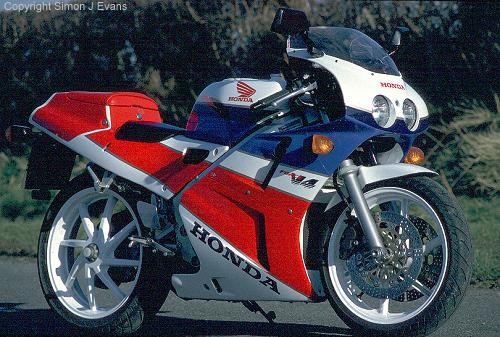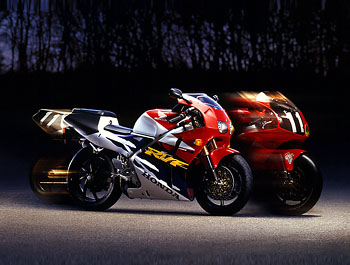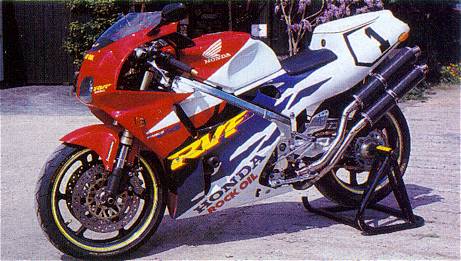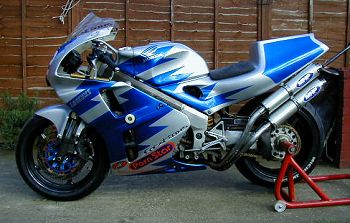Honda VFR400 NC30

The third incarnation of the VFR400 (the NC30) is an RC30 lookalike, and has turned out to be arguably the best 400cc sports bike. It had the best 400cc engine and by far the best looks, and has been the biggest seller. It was 'upgraded' to an RVF (NC35) in 1994 , echoing the lines of the RC45. In truth, it had a styling makeover, upside-down forks and a ram-air system but was virtually the same machine with virtually identical power and performance figures. The little VFR has proved itself to be popular by virtue of its brilliance. The review says it all:
You don't have to ride the NC30 to know that it is right. Everything about it just looks right. The scaled-down version of the RC30 is perfect in it proportions and in its detail. The reduction in size makes it neater still.The VFR400R was officially imported into the UK for 3 years, but failed to make an impact on the forecourt. The outrageous price (£5899) was not much less than a 1000cc superbike and a shade more than the VFR750. Not many were convinced by its looks and its race-shop pedigree to pay that much. Honda UK gave up importing them, since when grey importers have shipped thousands of secondhand bikes from Japan at much more favourable prices. The VFR400 is not only the most popular 400cc bike in the UK, but also the biggest-selling grey import. With the looks of a superbike and the v-four engine, that's no suprise. copyright Simon J Evans
The engine gives the impression of that of a larger machine. Peak torque is at 12,000rpm, but it doesn't drop off, giving a long, flexible spread of peak power. It will hold any top gear cruise speed up to 100mph, will pull wide open in top from 2,000rpm and runs without a hiccup to 15,000rpm.
Asked whether the quality of engineering is worth £6,000, the answer would be yes. The build quality is nearly as good as the RC30.
The VFR and RVF machines are still the most popular models in the Supersport 400 class at the TT. The NC30s have faced stiff opposition from Yamaha's FZR400s, and in 1998 the race was won on a specially prepared CBR400RR. However, a glance at the entry list will show that the V4's are prevalent, despite claims that they are very expensive to tune. The fact is that a high state of tune is not suitable over the mountain course at the TT, and the famed reliability of the Hondas is more valuable than a few more horsepower.
In 1994 I bought a 3,000-mile VFR400 for £3900. I had saved hard to get hold of the bike I had read was the next best thing to an RC30. I wasn't disappointed. The bike lived up to all my dreams, and proved to be a great machine. I sold it for a Yamaha YZF750 and, while the Yamaha is a good sports bike, I regretted it within weeks. The subsequent acquisition of a 1998 Fireblade took me a little way toward recapturing those elusive qualities, but there is still a rumbling that says "Sorry, but it ain't no VFR".
The VFR400 was featured in Bike magazine's secondhand buyer's guide, in the October 2001 issue. These are some of the things they said:
It doesn't matter who you are or what sort of bike you ride you can't fail to be impressed by the NC30. It is quite simply the best sportsbike under 600cc, with the possible exception of the Aprilia RS250. Beautifully engineered, beautifully built and beautifully finished, it exudes such quality that you wonder how they built it at the price.Most bikes on UK roads are parallel imports, invariably from Japan. The UK bikes featured two colour schemes, both red, white and blue (the earlier colours are as in the photograph at the top of this page, while the 1991-1993 bikes had a red front and tank). Japanese bikes had a wider variety of colours, such as silver & black, and red & black. The frame and engine numbers will tell you whether it is a UK-spec bike or an import. UK bikes should start with the following: copyright Simon J Evans
Reliable? Absolutely, assuming that it's been properly maintained. The charging system is a bit suspect, but that's it. Check the trueness of the wheels - they distort easily.
[Note: Regulator/rectifiers can fail, just like the bigger VFRs, that's all].
Competition: There isn't any, really. The NC35 is even more gorgeous (and expensive), an utter work of art. The CBR400 is a contender. It's another wonderful miniature road burner with superlative handling and a tough engine, but it just doesn't have the quality feel that you get with the NC30.
Engine: 2100007 or 2200001
Frame: 2000006 or 2100001
| VFR400R NC30 (1990) | |
| Front tyre Rear tyre Wheelbase Dry weight Power Torque |
120/70 150/60 (18" rim) 1345mm 170kg 56bhp @ 12,750rpm 26 lb-ft @ 9,700rpm |
Honda RVF400 NC35

Once the RC45 became the World Superbike homologation model Honda revised the 400cc machine to look like the bigger bike. The result is the RVF400. Underneath the curvy bodywork the engine and frame are more or less identical. The main differences are in the change of carburettors and use of upside-down forks. Performance is very similar to the VFR400.
I always thought the RVF was merely a VFR400 with new clothes until I found Bike magazine's report from the launch of the RVF in Japan. Their Japanese correspondent at the time, Yuko Sugeta, provided a report from the launch of the RVF400 for the May 1994 issue. It sheds some light on the changes from the VFR400. One can be forgiven for thinking the RVF is an NC with new clothes and a 17inch wheel (the UK bike mags often don't know the little differences, but don't get me started on that one!), but there is more to it that that:
With the NC30 you had to choose your line very carefully when entering a bend, but on the RVF almost any line will do. You don't have to be nervous about braking, leaning or opening the throttle. The RVF is very easy to control even at high speed.To me this reads too much like a press release, but I suppose Honda would not have made the changes if they weren't beneficial (I'm thinking particularly of smaller carbs etc). However, I have read more than once that the NC30's larger carbs give more power, and are the preferred choice for those wishing to race their RVF400. The NC30 could never have been accused of being peaky. Perhaps the development of the RVF was due to the importance of the home market, where machines are restricted to 53bhp. In this case, a wider torque spread would be more valuable than peak power, which would be about 60bhp without restriction.
The RVF uses cartridge-type upside-down forks with 41mm stanchions. Normally, inverted forks are much heavier than conventional forks. However, Honda engineers have succeeded in reducing weight using thinnner stanchions and lighter springs. There's also a new aluminium twin spar frame which, at first sight, looks very similar to the previous VFR. But the way it holds the engine is different and mimics the RC45 with the spars extending down to the engine cases, connecting with four bolts. The single-sided Pro-Arm has an improved leverage ratio and uses needle bearings to make the shock more responsive.
According to Honda's technicians they improved front forks first, then the main frame, and finally the Pro-Arm to balance the flexibility of the bike. The Pro-Arm's 17mm pivot shaft is thinner than the 20mm on the NC30 with the bearing reduced to balance rigidity with the forks and main frame. The riding position has also been changed: the handlebars are 24mm nearer the rider and 10mm higher than the VFR400's. It's still a racer-replica style, but more upright.
Intake ports have ben narrowed to increase the speed of air to the combustion chamber and the engine has been lightened by 0.5kg due mainly to the use of hollow camshafts. The carburettors are also 2mm smaller than before and have been fitted with T-section vacuum pistons. Compared to conventional circular sectin pistons there is less resistance to lifting as the area of the bottom of the piston is smaller. Thanks to these changes, the engine has become very responsive and produces a very gentle power curve from low revs right up to the red line. It is definitely not peaky.
Ms Sugeta describes the bike as "flexible", and it seems that the RVF's frame was designed to incorporate a degree of flex. This is an idea taken from Grands Prix, where the Wayne Rainey's Yamaha team found the older chassis (particularly Serge Rosset's design, used by privateers) was easier to ride than with the factory's latest super-stiff frame. Suddenly absolute rigidity was not the goal, and controlled flex was considered a good thing. Quite how Honda have done this is not disclosed. The only way to assess the improvements of the RVF over the NC30 would be to ride both back-to-back, preferably using two relatively new bikes. Only then could a rider determine the value of the changes to him or herself. In the UK RVF400s are still particularly expensive, costing as much as 750cc and 900cc superbikes of the same age.

A gorgeous tweaked RVF400, owned by BMC Motorcycles, of Whitchurch in England.
BMC sell their own rear linkage and WSB-lookalike exhaust for the RVF400.
BMC are on 01948 667976.
Buying Tips (both models) copyright Simon J Evans
- Always check for a toolkit - the plug spanner is essential.
- Look for poorly fitting panels and fasteners. The bodywork is expensive (though fits beautifully), so it is tempting to botch any minor repairs.
- Failing rectifiers are more common than should be the case. A regular check across the battery terminals with a multimeter is recommended. Hold the engine at 5,000rpm and it should read a steady 14.4 Volts.
- The high first gear (good for 65mph) means the clutch has a hard time. Vibration through the bars when the clutch lever is pulled in means the clutch thrust bearings need replacing. Thankfully, this is not a big job. Also, the cable clutch can break without warning, so if you intend keeping the bike for some time you could keep a spare in the shed.
- An M-Max plug in box will get you past the Japanese market top speed restriction of 112mph, while an HRC derestrictor - intended for Supersport racing - allows the engine to rev more freely. UK spec VFR400s do not require deristricting.
- Change the oil and oil filter frequently. 4,000 miles should be the maximum interval, and use good quality semi-synthetic oil. More frequent is better if you ride particularly hard, though the extra for fully synthetic oil is a needless expense.
Racing
The VFR and RVF have been prominent in Supersport 400 production-based racing over the years. While the 250cc two-strokes had it all their own way in the early 90s, the four-strokes have proved to be more reliable, and a better bet on road circuits like the TT. Setting up an RVF400 for racing is a straightforward task.Isle of Man-based racer Kevin Murphy has campaigned 400s for several years and found the RVF400 to be the best machine around. Modifications are limited to brake pads (EBC Double H), Denso Spark plugs and a Scorpion exhaust can with 115 main jets. Stock suspension copes well over the demanding TT course as well as on shorter circuits. He now has an ex-Honda Britain VFR400, a highly tuned machine, prepared by renowned tuner Tony Scott.
Supersport RVF400
Dave Harviek's RVF400 (right) was the fastest Honda in the Bemsee (fka BMCRC) Supersport 400cc championship, punting out a healthy 75bhp. Some of the modifications are listed below:- RLR stage 2 tune - Gas flowed head and quietening gears removed.
- RLR Ram air airbox
- RLR Carb kit and extended bellmouths
- HRC spec Ohlins rear shock
- HM Racing revalved and resprung fork with 0.85 springs
- Dymag 3.50 front and 5.25 rear rims
- Sprint steering damper
- Carbon Tek rearsets
- Ride height raised 10mm
- Total loss ignition
- HRC kit wiring loom
- RLR radiators

McGuinness wins 2003 TT on RVF400
John McGuinness won the 400cc class at the 2003 Isle of Man TT aboard an RVF400. John, one of the fastest men around the island circuit, rode an RLR Motorsports Honda RVF400 usually raced by Steve Tomes on the UK short circuits. Richard Britton, riding a Padgetts Honda CBR400, finished second, 26 seconds behind. On lap 3 McGuinness set a fastest lap of 111.36mph.McGuinness and RVF400 success at 2004 NW200 and TT
Riding his RVF400 at the North West 200, John McGuinness took the totally blitzed the opposition. He set a new Lap Record of 103.061mph that was well inside the old record of 96.193mph and his new Race Record was 102.665mph.John also swept to victory at the TT aboard the diminutive Honda. He won what was expected to be the last 400cc Lightweight race in a time of 1hr 22min 6.4s (110.28mph) and set a new lap record of 20min 12.3s (112.04mph) on lap 2 out of 4. The organisers had announced that the 400cc Lightweight and 125cc Ultra-Lightweight races would not be included in the programme from 2005. Personally I feel this is a shame, as the smaller classes are no less exciting than the bigger bikes, but there you go.
Maria Costello racing the RVF400
In 2005 Maria Costello MBE became the first ever woman in history to take a podium finish in either a TT or Manx GP. She took third place in the Ultra-lightweight race at the Manx GP aboard a RLR Motorsports Honda RVF400, provided by Tim Bradley. Earlier in the year she had succeeded in finishing third 400cc in the combined 125/400cc race at the North West 200, and placed 7th overall. In 2008 she finished 6th place in the Ultra Lightweight race aboard her CMS Honda RVF400, with an average speed of 103.668mph (photos at the Gooseneck by Dave Kneen here and here). This was her first finish on the TT course since a nasty crash in 2006. Gutsy riding, Maria!Maria is still riding the RVF in 2010, finishing third 400 at the Cookstown 100. In August 2010 She became the fastest woman to lap the fastest road race in the world, the Ulster Grand Prix (though not on her RVF), and was 21st in the 125/400/Supertwins race and 2nd 400cc rider to finish. There is an account of her trip, and you can see a photo of Maria giving the RVF some stick on this page (click the thumbnail for a bigger pic).
NC21 / NC24 / VFR400Z
These were the predecessors to the NC30. Both were called VFR400R. The earlier bike, the NC21 (1986-1987), was very similar to the VFR750 of the day in appearance. It had three-spoke Comstar wheels, 16 inch front and 18 inch rear. The VFR400Z was an unfaired version of the NC21, with twin headlights and a small bellypan. It would be an ideal cheap, unsophisticated runabout, with the bonus that it features the V4 engine.The NC24, sold from 1987-1989, featured a single-sided swingarm, and the high-level exhaust exited up the right hand side of the machine. It was apparently 18kg (40lb) heavier than the NC30 which succeeded it in 1989. All these earlier models used the 180-degree crank layout like the VFR750.
The earlier VF400 and VF500 machines are not covered here. There is a link to a VF site from the VF1000R page.
Related sites
RLR Motorsports provide race-winning tuning work and aftermarket parts for the Honda RVF400.
Todd's RVF400 website for lots of images and information.
Wikipedia: RVF400
Andrew's VFR website includes some specifications.
Bits 'n' Bikes - a UK-based service selling secondhand Honda parts, especially 400s.
Grey import 400 site
A tuned VFR400 - 450cc conversion, HRC race carb setup and more!
Carl Salter's NC30 - rebuilt from scratch with lots of TLC.
Todd's RVF400 website for lots of images and information.
Wikipedia: RVF400
Andrew's VFR website includes some specifications.
Bits 'n' Bikes - a UK-based service selling secondhand Honda parts, especially 400s.
Grey import 400 site
A tuned VFR400 - 450cc conversion, HRC race carb setup and more!
Carl Salter's NC30 - rebuilt from scratch with lots of TLC.